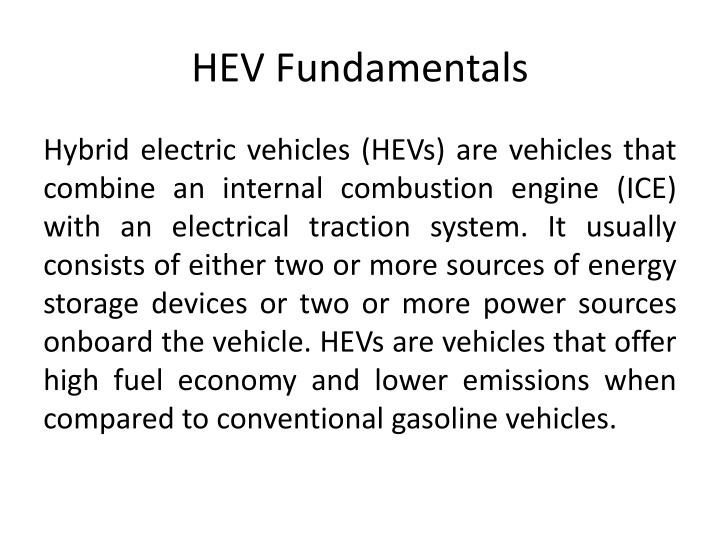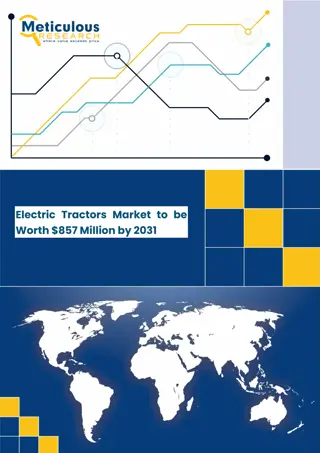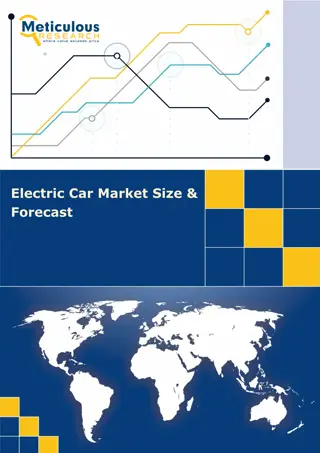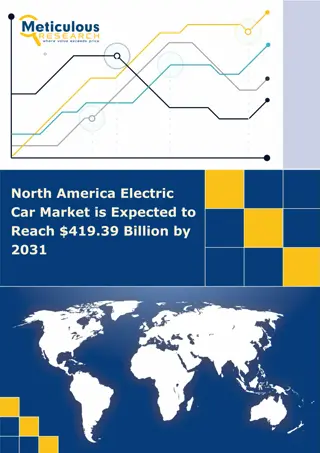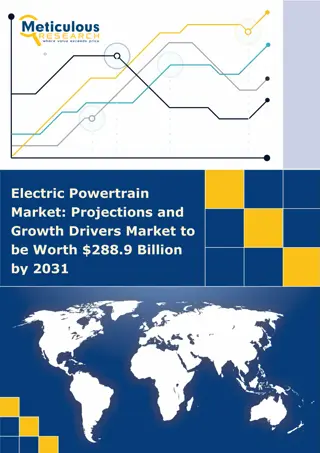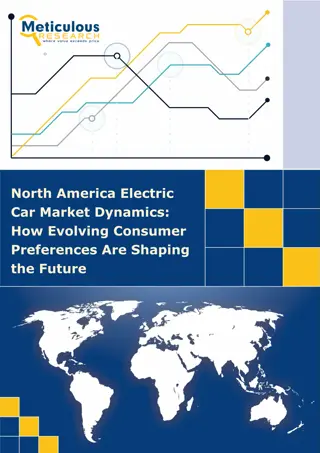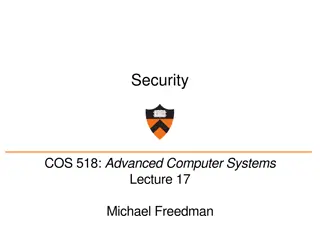HEV Fundamentals
Hybrid electric vehicles (HEVs) merge internal combustion engines with electrical traction systems to enhance fuel economy and reduce emissions. They utilize multiple energy storage devices or power sources, offering advantages like regenerative braking, improved fuel efficiency, and reduced greenhouse gas emissions. HEVs come in various configurations such as series hybrid, parallel hybrid, and plug-in hybrid, requiring careful selection and verification of propulsion engine ratings, electric motors, generators, and energy storage for optimal vehicle performance.
Download Presentation

Please find below an Image/Link to download the presentation.
The content on the website is provided AS IS for your information and personal use only. It may not be sold, licensed, or shared on other websites without obtaining consent from the author.If you encounter any issues during the download, it is possible that the publisher has removed the file from their server.
You are allowed to download the files provided on this website for personal or commercial use, subject to the condition that they are used lawfully. All files are the property of their respective owners.
The content on the website is provided AS IS for your information and personal use only. It may not be sold, licensed, or shared on other websites without obtaining consent from the author.
E N D
Presentation Transcript
HEV Fundamentals Hybrid electric vehicles (HEVs) are vehicles that combine an internal combustion engine (ICE) with an electrical traction system. It usually consists of either two or more sources of energy storage devices or two or more power sources onboard the vehicle. HEVs are vehicles that offer high fuel economy and lower emissions when compared to conventional gasoline vehicles.
Hybrid vehicles combine the ICE and electrical traction machine in an efficient way so as to utilize the most desirable characteristics of both. In HEVs, the ICE is mainly used for steady state operation while the electric machine powertrain is mainly used for dynamic operation. Some of the advantages offered by HEVs are as follows:
Efficiency-improving braking which is not available in conventional vehicles. technology such as regenerative Less engine idling and efficient engine operation leading to better fuel economy. Better drivability since electric motor characteristics better match the road load. Potential to reduce the emission of greenhouse gases. Reduced fossil fuel consumption.
HEVs configuration of the drivetrain as series hybrid, parallel hybrid, series parallel hybrid, complex hybrid, and plug-in hybrid. can be classified based on the
In general, when we design a HEV, we need to select the ratings for the propulsion engine, traction electric motor, generator, and energy storage based on the desired vehicle performance. After the initial design, we need to verify if the vehicle performance specifications are met. The design usually requires a modeling and simulation program and may take several iterations before final design.
Vehicle Model In this section, the vehicle is modeled as a road load. The vehicle and the associated forces are illustrated in the following Figure.
The force due to the road grade depends on the mass of the vehicle Mv, road angle in degrees , and gravitational acceleration g. The equation for this force is:
The road load curves of a vehicle for varying road angles are shown in the following Figure. The vehicle parameters are listed in the following table Table. It can be observed that the road load increases with the velocity and with road angle.
Vehicle Performance For any vehicle design, the performance constraints to be met must be defined first. These constraints are different depending on the vehicle type and size. From the powertrain point of view, typical performance specifications acceleration, cruise speed, gradability, drive range, and so on. Acceleration rate is the minimum time required to accelerate the vehicle from 0 to a specified speed such as 40, 60, or 80 mph. Sometimes acceleration rate from a lower speed to a higher speed is specified; for example, from 40 to 60 mph. include maximum initial speed,
Maximum acceleration is limited by maximum tractive power and roadway gradability is the maximum grade that a vehicle can move along at a certain speed with the maximum tractive force available from the powertrain. Drive range refers to the distance, in miles or kilometers, that a vehicle can travel with a full tank of fuel and/or fully charged batteries before refueling or recharging. Satisfactory drive range of an electric vehicle (EV) or HEV is crucial for market acceptance. condition. The
The US PNGVs (Partnership for a New Generation of Vehicle s) performance goal for mid-size vehicles is as follows: 0 60 mph: 12 seconds 40 60mph: 5.3 seconds 0 85 mph: 23.4 seconds Maximum speed: 85 mph Maximum grade at 55 mph: 6.5%.
Drive cycles are standard vehicle speed versus time profile for testing vehicle performance, fuel economy, and emissions. For example, the Federal Highway Driving Schedule (FHDS) and Federal Urban Driving Schedule (FUDS) are plotted in the following Figure:
The required power for operating a vehicle can be calculated from the driving cycles, depending on the mass of the vehicle. For example, the required power for driving a vehicle with a total weight of 1380 kg under US06 driving cycle is shown in the follwoing Figure. US06, the aggressive driving cycle, was proposed by the US Environmental Protection Agency (EPA) to measure fuel economy and emissions. The positive power is due to acceleration while the negative power is due to deceleration. Part of the negative power corresponding to braking can be recovered through regeneration in the HEV.
The fuel economy refers to how many miles a vehicle can travel with the consumption of per unit of fuel. One common unit is miles per gallon or MPG. For EVs or HEVs, miles per gallon gasoline equivalent (MPGGE) is used to measure how many miles a vehicle can travel with the consumption of energy equivalent to the amount released from combustion of 1 gallon of gasoline. Fuel economy of HEVs also depends on the drive cycles. Thus, sometimes, composite fuel economy or combined fuel economy is used. For example, composite fuel economy can be computed as the weighted average of the state of charge (SOC) balanced fuel economy values during the city drive cycle and highway drive cycle, as given below:
EV Powertrain Component Sizing As discussed earlier, when we size the powertrain of an EV, we must ensure sufficient tractive force for the vehicle to: accelerate from zero speed to a certain speed within a required time limit; overcome wind resistance force if headwind speed is non-zero; overcome aerodynamic force; overcome rolling resistance; climb a certain slope (grade).
The power and energy requirement from the powertrain is determined from a given set of vehicle cruising and acceleration specifications. EV/HEV design is an iterative process and requires many engineers disciplines to collaborate to meet design goals. Thus: from multiple
Electrical and mechanical engineers design the electric motor for the EV or the combination of electric motor and ICE for HEVs. Power electronics engineers design the power conversion circuit which links the energy source with the electric motor. Control engineers working in conjunction with the power electronics engineers develop the propulsion control system. Electrochemists and chemical engineers design the energy source based on the energy requirement and guidelines of the vehicle manufacturer.
